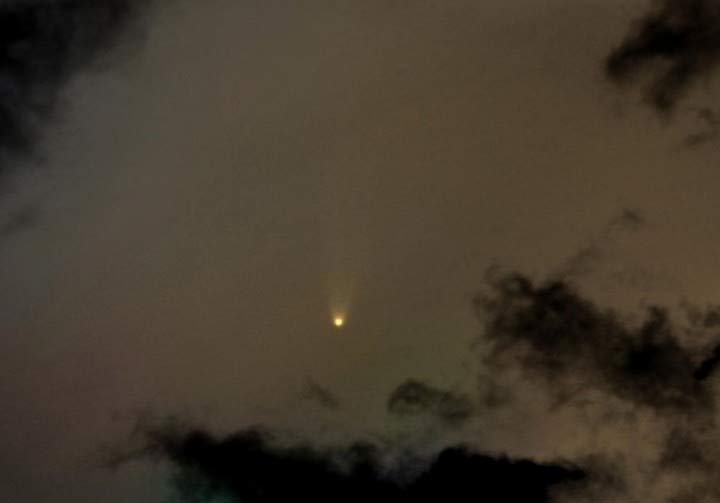New Comet is Brightest in 30 Years

UPDATE: See new SOHO images of the comet plus our latest coverage here.
A newfound comet is about to loop around the Sun and might offer skywatchers a rare and fantastic view. But comets are unpredictable, and this one has a wide range of possible outcomes, experts say.
When Australian astronomer Robert McNaught announced Aug. 7 that he had discovered a faint comet on a photograph taken at the Siding Spring Observatory in New South Wales, it was a distant and inconspicuous object. But its orbital motion at once made it clear that this comet, officially catalogued as C/2006 P1, might grow very bright right about now.
| Update: Brightest in 30 Years! Comet McNaught has become the brightest comet in 30 years, according to the International Comet Quarterly at the Harvard-Smithsonian Center for Astrophysics. Tonight (Wednesday, Jan. 10) may be the best chance for Northern Hemisphere viewers to spot it. But this comet remains a challenge. You need a very clear view of a very flat horizon and good sky conditions. Look for it moments after sunset. At magnitude -2, McNaught is brighter than was Hale-Bopp in 1995. | Update: Brightest in 30 Years! | Comet McNaught has become the brightest comet in 30 years, according to the International Comet Quarterly at the Harvard-Smithsonian Center for Astrophysics. Tonight (Wednesday, Jan. 10) may be the best chance for Northern Hemisphere viewers to spot it. But this comet remains a challenge. You need a very clear view of a very flat horizon and good sky conditions. Look for it moments after sunset. At magnitude -2, McNaught is brighter than was Hale-Bopp in 1995. |
| Update: Brightest in 30 Years! | ||
Comet McNaught has become the brightest comet in 30 years, according to the International Comet Quarterly at the Harvard-Smithsonian Center for Astrophysics. Tonight (Wednesday, Jan. 10) may be the best chance for Northern Hemisphere viewers to spot it. But this comet remains a challenge. You need a very clear view of a very flat horizon and good sky conditions. Look for it moments after sunset. At magnitude -2, McNaught is brighter than was Hale-Bopp in 1995. |
- Images: Comet McNaught Gallery
-SPACE.com Staff
Comet McNaught's orbit [video] indicates that it will sweep to within just 15.8 million miles (25.4 million kilometers) of the Sun on Jan. 12. This rather close approach-less than half the average distance of Mercury, the closest planet to the Sun-suggests the comet has the potential to briefly evolve into a bright object. The big question is, just how bright?
Brighter than Venus?
Recent estimates have ranged widely from magnitude +2.1 (about as bright as Polaris, the North Star) to a dazzling -8.8 (about 40 times brighter than Venus)!
Breaking space news, the latest updates on rocket launches, skywatching events and more!
[The lower the magnitude number, the brighter the object. The brightest stars in the sky are categorized as zero or first magnitude. Negative magnitudes are reserved for the most brilliant objects: the brightest star is Sirius (-1.4); the full Moon is -12.7; the Sun is -26.7. The faintest stars visible under dark skies are around +6.]
The reason for the great uncertainty stems from the fact that for the past few weeks the comet has been positioned at such a relatively small angular distance from the Sun in the sky that it has been extremely difficult to get good measurements of its brightness. Now, with a little over a week to go before the comet makes its closest approach to the Sun (called perihelion), just how bright it may ultimately get and how long a tail may develop remain to be seen.
Predicting a newly discovered comet's brightness has proven historically to be difficult, especially around the time of perihelion.
Spot it now
This is the 31st comet to bear McNaught's name and at time of discovery, it was no brighter than magnitude 17-far to dim to see with the naked eye.
Observers have followed its gradual brightening as its distances from Sun and Earth decreased. It's currently both a morning and evening object, visible very low near the east-southeast horizon about 30 to 40 minutes before sunrise and very low near the west-southwest horizon about 30 to 40 minutes after sunset.
During this upcoming week, prospective observers should seek the most favorable conditions possible. Even a bright comet can be obliterated by thin horizon clouds, haze, humid air, smoke, twilight glow, city lights, or moonlight. Binoculars are strongly recommended for locating it.
But the past few days, reports suggest that Comet McNaught is becoming easier to sight even through the bright twilight glow. [Sky Maps: Morning, Evening]
Bright outlook
David Moore reported seeing the comet on New Year's Day evening from Dublin, Ireland. He writes: "After searching for over half an hour in strong twilight I saw it easily in 20x80 binoculars from an upstairs window. I could see a small fuzzy and surprisingly bright head about as bright as the mag 3.5 star Lambda Aquilae 6 degrees above it. That said, it was not an easy observation given the strong twilight and the comet was only 3.0 degrees above the horizon!"
Well-known comet observer, John Bortle of Stormville, New York caught sight of the comet just before sunrise with 15 x 80 binoculars on Jan. 2.
"My eastern view was largely obstructed by trees," Bortle said. "Still it was somewhat amazing to see the comet against such a bright sky and through all those tree branches! From experience in making similar observations, I'd judge that it was not any fainter than 2nd magnitude."
Regardless of just how bright Comet McNaught becomes, beginning on Friday, Jan. 12 and continuing through Monday, Jan. 15, it will be passing through the field of view of the Solar and Heliospheric Observatory ("SOHO"); a spacecraft that was launched in 1995 to study the Sun.
Astronomers hope to get spectacular views of the comet by utilizing SOHO's LASCO C3 camera, whose images can also be viewed in real time here.
UPDATE: See new SOHO images of the comet plus our latest coverage here.
How to Watch
- Video: Comet McNaught's Orbit
- Watch Comet McNaught: Live Sun Cam (may load slowly)
- Expected Track of Comet McNaught in SOHO Camera
- Images: Comet McNaught Gallery
More to Explore
- Images: Great Comets
- Comet Plunges into the Sun
- Video: Comets Through Time ... Myths and Mystery
- Monthly Sky Calendar & Moon Phases
- 10 Steps to Rewarding Stargazing
- Astrophotography 101
- Venus Viewer's Guide
- All About Comets
Joe Rao serves as an instructor and guest lecturer at New York's Hayden Planetarium. He writes about astronomy for The New York Times and other publications, and he is also an on-camera meteorologist for News 12 Westchester, New York.

Joe Rao is Space.com's skywatching columnist, as well as a veteran meteorologist and eclipse chaser who also serves as an instructor and guest lecturer at New York's Hayden Planetarium. He writes about astronomy for Natural History magazine, Sky & Telescope and other publications. Joe is an 8-time Emmy-nominated meteorologist who served the Putnam Valley region of New York for over 21 years. You can find him on Twitter and YouTube tracking lunar and solar eclipses, meteor showers and more. To find out Joe's latest project, visit him on Twitter.
